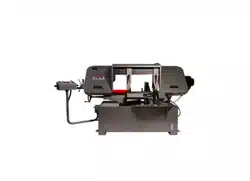Loading ...
Loading ...
Loading ...

14
NOTE: In auto mode, Bow Up/Down and Vise
Open/Close buttons (E/F/G/H) are rendered inactive
while blade is engaging workpiece.
If E-stop (D) is pressed in auto mode, all functions
will cease. While E-stop is engaged, you may press
and hold Blade Up button (E) to return bow to raised
position. Release the button and bow will stop
functioning. To resume operations, rotate E-stop
button clockwise until it disengages.
10.3 Blade selection
The HBS-1220MSA/H is provided with a blade
adequate for a variety of jobs on a variety of
common materials. A 4/6 vari tooth bi-metal blade
(5512107) and a 6/10 vari tooth bi-metal blade
(5512108) are also available from JET.
Sect. 12.0 shows recommended speeds for various
materials. These selections, while appropriate for
many shop cutting needs, do not encompass the
wide variety of blades of special configuration (tooth
pitch and set) and special alloys for cutting unusual
or exotic materials.
A coarse blade could be used for a solid steel bar
but a finer tooth blade would be used on a thin-wall
tube. In general, the blade choice is determined by
the thickness of the material; the thinner the
material, the finer the tooth pitch.
A minimum of three teeth should be on the
workpiece at all times for proper cutting. The blade
and workpiece can be damaged if the teeth are so
far apart that they straddle the workpiece.
For very high production on cutting of special
materials, or for hard-to-cut materials such as
stainless steel, tool steel, or titanium, ask your
industrial distributor for more specific blade
recommendations.
Also, the supplier who provides the workpiece
material should be prepared to provide very specific
instructions regarding the best blade (and coolant or
cutting fluid, if needed) for the material and shape
supplied.
10.4 Blade break-in procedure
New blades are very sharp and, therefore, have a
tooth geometry which is easily damaged if a careful
break-in procedure is not followed. Consult the
blade manufacturer’s literature for break-in of
specific blades on specific materials. However, the
following procedure will be adequate for break-in of
JETsupplied blades on lower alloy ferrous materials.
1. Clamp a round section workpiece in the vise.
The workpiece should be 2 inches or larger in
diameter.
2. Set the saw on low speed. Start the cut with a
very light feed rate.
3. When the saw has completed 1/3 of the cut,
increase the feed rate slightly and allow the saw
to complete the cut.
4. Keep the same hydraulic cylinder setting and
begin a second cut on the same or similar
workpiece.
5. When the blade has completed about 1/3 of the
cut, increase the feed rate. Watch the chip
formation until cutting is at its most efficient rate
(see sect. 10.5) and allow the saw to complete
the cut.
6. The blade is now considered ready for regular
service.
10.5 Evaluating cutting efficiency
Is the blade cutting efficiently? The best way to
determine this is to observe the chips formed by the
cutting.
If chip formation is powdery, then feed rate is much
too light, or the blade is dull.
If chips are curled, but colored — that is, either blue
or straw-colored from heat generated during the cut
— then feed rate is too high.
If chips are slightly curled and are not colored by
heat, the blade is sufficiently sharp and is cutting at
an efficient rate.
11.0 User-maintenance
Always disconnect power to
machine before performing maintenance,
unless indicated otherwise. Failure to comply
may result in serious personal injury.
Clean up accumulated saw cuttings after use. Make
sure lead screw is kept free of saw cuttings and
other material that would cause damage.
Remove dust or debris from motor fan area with
compressed air or vacuum.
If power cord is worn, cut, or damaged in any way,
have it replaced immediately.
Release tension on blade if saw will not be used for
a time.
Periodically clean chip sludge from cutting fluid
basin.
A handle is provided for
manually lifting bow for servicing purposes. If
bow is raised without the assistance of the
hydraulic controls, use appropriate blocking to
prevent bow from falling. See Figure 11-1.
Failure to comply may cause injury.
Loading ...
Loading ...
Loading ...
